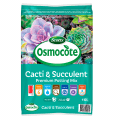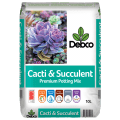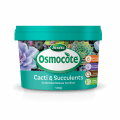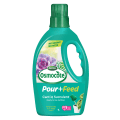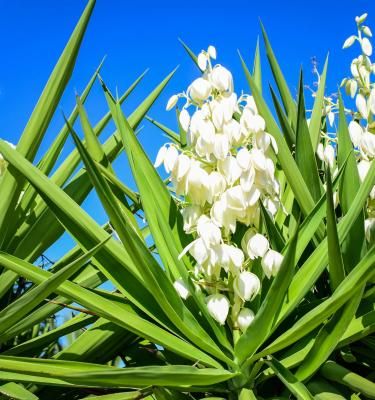

How and when to plant a yucca: A guide for Australian gardeners
Much like the popular monstera, yuccas are enjoying renewed popularity as indoor plants. But did you know that these striking plants can also thrive in outdoor gardens with mild climates or even on a sunny balcony? With their elegant white flowers blooming as early as October, yucca trees make a stunning addition to any space.
Here’s everything you need to know to grow and care for a healthy yucca plant!

Popular yucca plant varieties
Yuccas are hardy, evergreen perennials related to agaves and aloes. Most yucca species originate from South America and feature a trunk (known as a "stipe") topped with a rosette of lance-shaped leaves. These leaves can be green, blue-green, or variegated depending on the variety. While yuccas produce beautiful white cascades of flowers, they only bloom when grown outdoors.
Here are some popular varieties of yuccas for indoor or outdoor growing:
-
Yucca elephantipes (Giant Yucca): The most iconic and largest yucca, this plant can grow up to 5 metres tall in a pot. Its nickname, "elephant’s foot," comes from its thick base. It’s not frost-resistant, so it’s best suited for indoor spaces but can be moved outside during summer.
-
Yucca filamentosa (Adam’s Needle and Thread): This hardy variety can withstand temperatures as low as -5°C. It thrives in light, well-draining soils and produces clusters of white bell-shaped flowers in summer. Its name comes from the thin threads that appear at the tips of its leaves.
-
Yucca aloifolia (Spanish Bayonet): Commonly found in coastal or Mediterranean-style gardens, this yucca is moderately hardy and does well in sunny, sheltered areas.
-
Yucca recurvifolia (Bright Star): A unique cultivar with no trunk, this yucca boasts a rosette of variegated green and yellow leaves. Under the right conditions, the leaves may even develop a rosy tint. It’s perfect for sunny rockeries.
-
Yucca gloriosa (Spanish Dagger): A slow-growing yucca that can reach up to two metres tall. This variety tolerates occasional frosts and requires ample space for its sharp-edged leaves to spread.
-
Yucca rostrata (Blue Yucca): With striking blue-green foliage, this yucca is both highly decorative and hardy. It pairs beautifully with other rockery plants like agave and aloe and is protected by its dried leaves, which form a natural insulation around its trunk.
When to plant a yucca
Planting a yucca in your garden is best done in spring when the soil has warmed up and there’s no longer a risk of frost. This timing allows the yucca to establish itself before the heat of summer arrives.
For potted yuccas, planting can be done at any time of the year. However, it’s a good idea to repot the plant after purchase into a slightly larger container with a high-quality potting mix.
How to plant a yucca in the ground
When planting a yucca directly into the ground, preparation is key:
-
Choose a sunny, well-drained location.
-
Dig a hole that is wide and deep enough to accommodate the plant’s roots.
-
Mix garden soil with sand to improve drainage.
-
Place the yucca upright in the hole, ensuring it is stable.
-
Backfill the hole with the soil mixture and water thoroughly to help the plant settle.
Where to plant a yucca in your garden
If you live in a region with a mild climate, your garden provides the perfect environment for a yucca. Here’s what to consider when choosing the best location:
-
Sunlight: Yuccas thrive in bright, sunny spots but avoid areas with intense, direct afternoon sun that could scorch the leaves. A balance of full sun and some shade works well.
-
Soil: Yucca prefers dry, light soils that aren’t overly fertile.
-
Shelter: Choose a location that’s protected from cold winds, which can damage the foliage.
Take care when placing your yucca in high-traffic areas, as the sharp, pointed leaves can pose a risk, especially for kids or pets. For added visual appeal, yuccas pair beautifully with Mediterranean plants like bougainvillea or portulaca.
Did you know? Indoors, yuccas are prized not only for their aesthetics but also for their air-purifying properties, making them a functional addition to your home.
Yucca care: Outdoors
Yuccas are low-maintenance plants, whether grown indoors or outdoors. Here are some tips to keep your yucca thriving:
-
Watering: Yuccas prefer moderate watering. Allow the soil to dry out between waterings to avoid root rot. In winter, water sparingly, but increase watering during hot summer months.
-
Pruning: Remove dry or damaged leaves regularly. In outdoor gardens, leave dry leaves in place during winter to act as a natural protective layer.
-
Winter protection: For outdoor yuccas in colder climates, consider adding a protective covering during frosty periods. Potted yuccas can be moved to a sheltered, unheated veranda or patio to avoid extreme cold.
Yucca care: Indoor yuccas
Indoor yuccas are a fantastic addition to any home, combining beauty with practicality. To keep your yucca healthy indoors, follow these indoor yucca flower care tips:
-
Watering: Water sparingly during winter, allowing the soil to dry out between waterings. During summer, increase watering slightly.
-
Drainage: Always empty the saucer under the pot after watering to prevent the roots from sitting in water.
-
Repotting: Repot your yucca every two years into a slightly larger pot using the same method you used when you first planted it. For larger pots, consider surface dressing by replacing the top layer of soil with fresh potting mix.
-
Fertilising: Feed your indoor yucca with a specialised cacti and succulent slow release fertiliser in spring to promote growth.
-
Cleaning: Wipe the leaves with a damp cloth to remove dust and keep the plant looking its best.
How to cut yucca plants
Yucca plants can be cut to trim them, shorten them, or for propagation.
How to trim a yucca plant
For yucca plant pruning, use sharp pruning shears or a pruning saw to cut back the yucca plant to any size. Trim it after blooming or cut it back to fit your space. Cut at or near the trunk, leaving each stem bare.
How to shorten yucca plants
To shorten a yucca plant, cut it in half using a saw. Repot the bottom half of the trunk and water well.
How to propagate yucca plants
To propagate a yucca plant, cut a piece of mature wood from the base of the trunk using a sharp knife or saw. Put the cutting in a dry shady spot for a couple of days to dry out.
How to grow yucca cuttings
Once propagated, put the cutting in a pot with a well-draining potting mix, such as a cactus and succulent potting mix. Use a stake to prevent the cutting from falling over. Water well and wait for roots to establish (this should take about four weeks). Once the yucca plant has a decently sized root ball, plant it outside.
Pests and diseases
Yuccas are hardy plants and are rarely affected by pests or diseases when grown outdoors. However, indoor yuccas can occasionally face issues such as:
-
Scale insects, red spider mites, or aphids: These common pests can be controlled with appropriate insecticides. Always follow the product instructions carefully to avoid harming the plant.
-
Sooty mould: This fungal growth is often a secondary issue caused by pest infestations. Treating the underlying pest problem will usually resolve the mould.
With the right care, your yucca will remain a vibrant and healthy feature of your home or garden.
